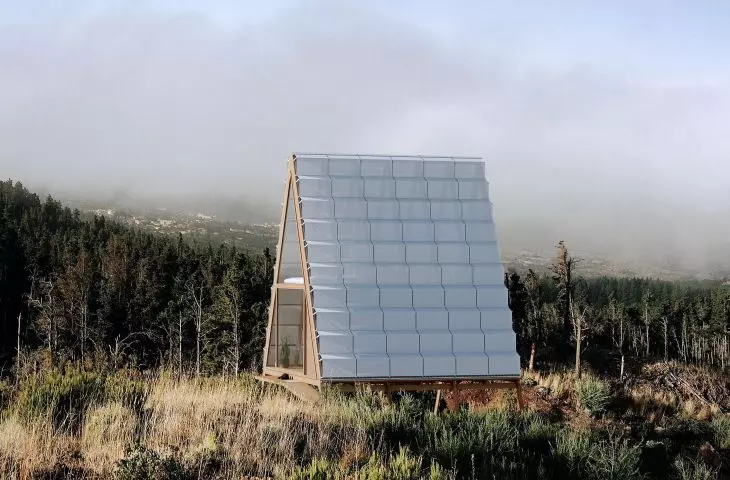Sleeping Pods on a Cliff is the third competition of the Bee Breeders platform concerning the picturesque area of Vale de Moses in Portugal. This time, the goal was to design simple, self-sufficient sleeping cabins located on the rocky slopes of the hill. Minimalist in expression, the Dew Catcher project by a Polish-Dutch team consisting of: Maciej Abramczyk and Marco Moretto won first place!
Vale de Moses Yoga Retreat is a place nestled in the pine and eucalyptus forests of central Portugal, visited by hundreds of international visitors every year. The former abandoned property, which was originally a farm, was purchased by a British family and restored. Over the past six years, the stone cottages and terraced forest gardens have been transformed into a place for yoga and meditation surrounded by nature.
Accommodation cabins are located at the Vale de Moses Yoga Retreat
© Maciej Abramczyk, Marco Moretto
Sleeping cabins in Portugal
This year's competition, called Sleeping Pods on a Cliff, was about designing a simple accommodation base - sleeping cabins that could accommodate several guests at a time. Each facility was to include a basic sleeping area and a washroom. The international jury composed of: Marta Frazão, Filipe Rodrigues and Inês Vicente (Atelier Data), Ricardo Gomes (KWY.studio), Samuel Gonçalves (SUMMARY), Jake Heffington, Mikhail Krymov (Sleepbox), Raulino Silva (Escola Superior Artística do Porto) were looking for projects with a focus on ecological solutions, sustainable construction and operation. An important aspect was the idea of a system that naturally purifies gray water so that it can be reused to irrigate forested hillsides.
Part of the Dew Catcher's facade is tiltable and opens up to a panoramic view of the valley
© Maciej Abramczyk, Marco Moretto
Dew Catcher with first prize
Among the numerous entries, the jury took notice of the project by architects Maciej Abramczyk and Marco Moretto, who live in the Netherlands, awarding it first prize. The authors proposed a simple A-shaped structure with a stepped, transparent polycarbonate roof overlaid with layers of nylon mesh, which captures dew and fog and thus supplies water to the cabin and surrounding vegetation.
The light and simple design and interesting solutions captured the competition jury
© Maciej Abramczyk, Marco Moretto
Formally simple but well-designed, the Dew Catcherproposal draws on the iconic image of a hut or tent treated as a shelter in the landscape, opening up to a panoramic view of the surroundings in unexpected ways. Sustainable and innovative! - reads the jury's opinion.
The cabin's lightweight, simple design, made of modest materials, captures moisture from the air - a valuable resource in an area prone to drought and forest fires. Taking advantage of local climatic conditions - varying levels of precipitation, but consistent high humidity throughout the year, the Dew Catcher condenses and collects fog and dew, ensuring a continuous supply of water: enough for the cabin, existing Vale de Moses buildings, crops and wild vegetation.
One cabin is capable of collecting 350 liters of water per day,
which can be used to irrigate the area
© Maciej Abramczyk, Marco Moretto
dew catcher cabin
Dew Catcher is not just a traditional sleeping cabin, but also a passive atmospheric moisture collection system. A gently undulating layer of nylon mesh collects mist and dew. Below, a translucent polycarbonate roof covering collects rain and moisture captured by the mesh. The collected water is stored in an integrated reservoir, and the excess is directed downward through a drip irrigation system, irrigating wild vegetation during droughts and helping to increase local biodiversity. The remaining water can be used by existing buildings and the adjacent garden.
It is estimated that a single cabin is capable of collecting 350 liters of water per day, 290 liters more than needed for its own operation. Annually, this represents 108 cubic meters of surplus water. The solution is scalable: the more cabins in the valley, the larger the area will be irrigated, and the barren slopes will gradually turn into a diverse forest, says Maciej Abramczyk.
The appearance of the cabin changes throughout the day, as well as during different seasons
© Maciej Abramczyk, Marco Moretto
changing appearance and unusual facade
The appearance of the cabin changes during the day and with the changing seasons. At night, the unrolled facade mesh captures fog and dew. The cabin lights up like a lantern, animated by the movement of the occupants inside. On warmer days, a tilting window and two revolving doors can be opened, turning the entire cabin into a spacious terrace. On cooler days, the net can be rolled up, and sunlight transmitted through translucent layers of polycarbonate helps warm the cabin's interior. After dark, the net is rolled back to resume collecting atmospheric moisture.
The shape of the cabin facilitates water collection
© Maciej Abramczyk, Marco Moretto
Theshape of the cabin maximizes the roof area for water collection. The façade grid is shaped to create vertical and inclined zones at thirty degrees, optimized for fog and dew collection, respectively.
Fog is collected on the vertical parts of the mesh as vapor-saturated air passes through the fabric. Dew condensation occurs on the inclined mesh when the air comes into contact with a surface cooled below the current dew point. The efficiency of the process depends on the high radiation cooling properties of the fabric and its ability to rapidly release heat. This property reaches a peak at a slope of thirty degrees," explains Maciej Abramczyk.
materials and construction
The Dew Catcher consists of easily assembled and transportable components: a modular frame made of laminated wood and a lightweight polycarbonate roofing. The architects also used recycled materials. The façade's shading grid and plywood interior finish make the cabin a simple, environmentally friendly and cost-effective solution for a hard-to-reach location.
The Dew Catcher consists of a modular wooden frame and polycarbonate roof
© Maciej Abramczyk, Marco Moretto
With the structure founded on eight supports that are extensions of the roof rafters, the cabin can be installed on uneven terrain anywhere in the valley with minimal interference with the landscape. The orientation of the building parallel to the hillside refers to the local morphology and minimizes the necessary supporting structure. The interior of the cabin is a spacious and unique space, and the tilting portion of the facade on hydraulic pistons opens up to a beautiful panorama of the Portuguese valley.
Previous competitions associated with the Vale de Moses Yoga Retreat have involved designs for meditation cabins and a yoga house. Read about komorebi, a Polish-Japanese duo, which won third prize, and the honorable mention project INSIDE|OUT by Wave Architecture. Meanwhile, the list of finalists in the yoga house concept competition included a project by kamecki.architektura and Passing Through by students of the Warsaw University of Technology.












































